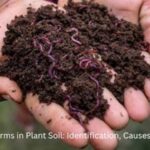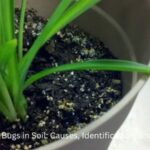Seeds and Germination
Soaking Seeds in Hydrogen Peroxide: Benefits and Methods for Successful Germination
Seed germination is a critical stage in the growth of any plant, and gardeners often look for ways to improve the chances of successful sprouting. One method that has gained popularity is soaking seeds in hydrogen peroxide before planting. This simple but effective technique can enhance seed germination, reduce the risk of fungal infections, and promote healthier growth. By understanding how and why hydrogen peroxide works, gardeners can use this method to give their seeds the best possible start.
In this article, Garden 02 will explore the science behind hydrogen peroxide, its benefits for seed germination, and the correct methods for soaking seeds. Whether you’re growing vegetables, flowers, or herbs, using hydrogen peroxide can boost your gardening success.
Table of Contents
Toggle1. Understanding Hydrogen Peroxide
Before diving into how hydrogen peroxide works for seed germination, it’s important to understand what this chemical is and how it functions.
1.1. What is Hydrogen Peroxide?
Hydrogen peroxide (H₂O₂) is a chemical compound made up of two hydrogen atoms and two oxygen atoms. It is commonly used as a disinfectant because of its ability to break down into water and oxygen, which makes it safe for many applications.
- Oxygen Release: When hydrogen peroxide breaks down, it releases oxygen. This process helps to aerate the soil and promote seed germination by providing seeds with additional oxygen, which is vital for their metabolic processes.
- Antimicrobial Properties: Hydrogen peroxide is known for its ability to kill bacteria, fungi, and other pathogens. By soaking seeds in hydrogen peroxide, you can help reduce the presence of harmful microbes that might hinder seed germination or cause diseases in seedlings.
1.2. Common Uses in Gardening
Gardeners have long used hydrogen peroxide for various purposes, including:
- Disinfecting gardening tools
- Treating root rot and fungal infections in plants
- Oxygenating soil and improving aeration
When used in seed germination, hydrogen peroxide can enhance seed viability and promote faster, more reliable sprouting.
2. Benefits of Soaking Seeds in Hydrogen Peroxide
Soaking seeds in hydrogen peroxide offers several advantages that can lead to improved germination rates and healthier seedlings. Here’s a look at the key benefits:
2.1. Enhances Germination Rates
One of the primary benefits of soaking seeds in hydrogen peroxide is its ability to increase oxygen availability. Seeds need oxygen to break dormancy and start the germination process. Soaking seeds in hydrogen peroxide helps:
- Increase Oxygen Exposure: The additional oxygen produced by hydrogen peroxide can penetrate the seed coat, stimulating faster metabolic activity and promoting quicker sprouting.
- Soften the Seed Coat: Some seeds, especially those with hard outer shells, can have difficulty absorbing water. Hydrogen peroxide helps soften the seed coat, making it easier for water and oxygen to reach the embryo inside.
2.2. Reduces Fungal Infections
Fungal infections can be a major obstacle to successful seed germination. Fungi thrive in the damp conditions necessary for seed germination and can cause problems such as damping-off disease, which leads to seedling death.
- Disinfecting Seeds: Hydrogen peroxide is an effective antifungal agent. Soaking seeds in hydrogen peroxide kills harmful fungi and bacteria that may be present on the seed’s surface, reducing the risk of infection during germination.
- Prevents Damping-Off: By eliminating potential fungal threats before planting, you increase the chances of your seedlings avoiding the damping-off disease, a common issue caused by fungal pathogens attacking young seedlings.
2.3. Boosts Seedling Health
Healthy seeds lead to vigorous seedlings. By reducing the risk of pathogens and enhancing oxygen uptake, hydrogen peroxide can result in stronger, more robust plants that are better equipped to handle environmental stressors.
- Improves Root Development: Hydrogen peroxide promotes healthy root growth by oxygenating the soil around the seed. Strong roots are essential for nutrient uptake and overall plant health.
- Enhances Growth: Seeds that germinate quickly and in optimal conditions often produce stronger seedlings with more resistance to pests and diseases.
3. Types of Seeds That Benefit from Hydrogen Peroxide Soaking
Not all seeds require soaking, but certain types can significantly benefit from the process. Some seeds have naturally hard coats or are more susceptible to fungal infections, making them ideal candidates for a hydrogen peroxide treatment.
3.1. Hard-Shelled Seeds
Seeds with tough outer shells, such as peas, beans, and some flower seeds, often have difficulty absorbing water and oxygen through their seed coat. Soaking these seeds in hydrogen peroxide can help soften the shell, making it easier for the seeds to break dormancy and sprout.
3.2. Old Seeds
As seeds age, their germination rates tend to decrease. Soaking older seeds in hydrogen peroxide can improve their chances of germinating by providing them with a fresh source of oxygen and removing any microbial contamination that might have developed over time.
3.3. Seeds Prone to Fungal Infections
Some seeds are more susceptible to fungal infections, especially in humid environments. Lettuce, tomatoes, and other delicate seeds can benefit from hydrogen peroxide soaking to protect them from pathogens during the germination process.
3.4. Seeds Used for Indoor Seed Starting
Seeds started indoors, such as those for vegetable gardens, are often grown in humid conditions that can encourage the growth of fungi. Hydrogen peroxide soaking is especially useful for seeds started in indoor trays or greenhouses, where moisture and warmth can create ideal conditions for fungal problems.

4. How to Soak Seeds in Hydrogen Peroxide
Now that you understand the benefits of soaking seeds in hydrogen peroxide, let’s look at how to do it properly. The process is simple but requires careful attention to concentration and timing to ensure you don’t damage the seeds.
4.1. Materials Needed
To soak seeds in hydrogen peroxide, you will need the following materials:
- Hydrogen peroxide (3% concentration, the common type found in stores)
- Water
- A small bowl or container
- A fine-mesh strainer or cheesecloth
- Seeds
4.2. Steps for Soaking Seeds in Hydrogen Peroxide
Follow these steps to soak your seeds and prepare them for planting:
Step 1: Dilute the Hydrogen Peroxide
Although hydrogen peroxide is safe in low concentrations, it’s important to dilute it with water to avoid damaging the seeds. For a 3% hydrogen peroxide solution, mix one part hydrogen peroxide with two parts water. This will create a mild solution that’s safe for most seeds.
Step 2: Soak the Seeds
Place the seeds in a small bowl or container, and pour the diluted hydrogen peroxide solution over them. Make sure the seeds are fully submerged in the solution.
Step 3: Timing the Soak
Soak the seeds for about 30 minutes. This is enough time for the hydrogen peroxide to disinfect the seeds and soften the seed coat without causing any harm. For particularly hard-coated seeds, you may extend the soaking time to 1-2 hours, but avoid soaking for too long, as this can damage the seeds.
Step 4: Rinse the Seeds
After the soaking period, strain the seeds using a fine-mesh strainer or cheesecloth. Rinse them thoroughly under cool, running water to remove any residual hydrogen peroxide. This ensures that no chemical remains on the seed surface that could potentially harm the plant as it begins to grow.
Step 5: Plant the Seeds
Once the seeds have been soaked and rinsed, they are ready for planting. Follow the planting instructions for your specific seed type, ensuring that you provide the proper depth, light, and moisture for successful germination.
5. Additional Tips for Seed Germination Success
Soaking seeds in hydrogen peroxide is just one step in the overall germination process. Here are some additional tips to ensure successful seed sprouting and healthy seedling development:
5.1. Temperature Control
Most seeds germinate best at temperatures between 65°F and 75°F (18°C to 24°C). Use a seed-starting mat or place your seed trays in a warm area to maintain consistent temperatures during the germination process.
5.2. Moisture Management
Keep the soil or growing medium consistently moist but not waterlogged. Overwatering can lead to root rot and fungal growth, while dry conditions can prevent seeds from germinating. Use a spray bottle to mist the soil lightly and maintain an even moisture level.
5.3. Use of Sterile Growing Medium
When starting seeds indoors, it’s important to use a sterile growing medium to reduce the risk of fungal infections. Sterile seed-starting mixes are designed to promote healthy germination by providing an optimal balance of moisture, aeration, and nutrients.
5.4. Proper Light Exposure
Once seeds germinate, most seedlings require plenty of light to grow strong and healthy. Place your seedlings in a sunny window or under grow lights to ensure they receive enough light to develop properly.
6. Common Mistakes to Avoid
While soaking seeds in hydrogen peroxide is generally safe, there are a few common mistakes that can reduce the effectiveness of the process or harm your seeds. Avoid these pitfalls to ensure successful seed germination:
6.1. Using the Wrong Concentration
Always use a 3% hydrogen peroxide solution for soaking seeds. Stronger concentrations can damage seeds, while weaker solutions may not provide the desired benefits.
6.2. Over-Soaking
Soaking seeds for too long can cause them to become waterlogged or even kill them. Stick to the recommended soaking time of 30 minutes to 2 hours, depending on the seed type.
6.3. Skipping the Rinse
Failing to rinse the seeds after soaking can leave behind hydrogen peroxide residue, which may harm the seedlings. Be sure to thoroughly rinse the seeds under cool water after soaking.
7. Conclusion
Soaking seeds in hydrogen peroxide is an effective and easy way to improve germination rates, reduce fungal infections, and promote healthy seedling growth. By providing seeds with extra oxygen and protecting them from harmful pathogens, this method can lead to stronger, more vigorous plants. Whether you’re a seasoned gardener or just starting, incorporating hydrogen peroxide into your seed-starting routine can help ensure a successful growing season.
With the right preparation, care, and attention to detail, you can give your seeds the best possible start, leading to a bountiful garden full of healthy, thriving plants.





